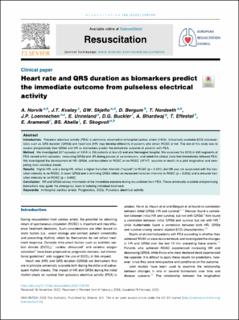| dc.contributor.author | Norvik, Anders | |
| dc.contributor.author | Kvaløy, Jan Terje | |
| dc.contributor.author | Skjeflo, Gunnar Waage | |
| dc.contributor.author | Bergum, Daniel | |
| dc.contributor.author | Nordseth, Trond | |
| dc.contributor.author | Loennechen, Jan Pål | |
| dc.contributor.author | Unneland, Eirik | |
| dc.contributor.author | Buckler, D.G. | |
| dc.contributor.author | Bhardwaj, A. | |
| dc.contributor.author | Eftestøl, Trygve Christian | |
| dc.contributor.author | Aramendi, E. | |
| dc.contributor.author | Abella, BS. | |
| dc.contributor.author | Skogvoll, Eirik | |
| dc.date.accessioned | 2024-04-04T08:49:58Z | |
| dc.date.available | 2024-04-04T08:49:58Z | |
| dc.date.created | 2023-03-20T08:49:54Z | |
| dc.date.issued | 2023 | |
| dc.identifier.citation | Resuscitation. 2023, 185 . | en_US |
| dc.identifier.issn | 0300-9572 | |
| dc.identifier.uri | https://hdl.handle.net/11250/3124779 | |
| dc.description.abstract | Introduction:Pulseless electrical activity (PEA) is commonly observed in in-hospital cardiac arrest (IHCA). Universally available ECG characteristics such as QRS duration (QRSd) and heart rate (HR) may develop differently in patients who obtain ROSC or not. The aim of this study was to assess prospectively how QRSd and HR as biomarkers predict the immediate outcome of patients with PEA.
Method: We investigated 327 episodes of IHCA in 298 patients at two US and one Norwegian hospital. We assessed the ECG in 559 segments of PEA nested within episodes, measuring QRSd and HR during pauses of compressions, and noted the clinical state that immediately followed PEA. We investigated the development of HR, QRSd, and transitions to ROSC or no-ROSC (VF/VT, asystole or death) in a joint longitudinal and competing risks statistical model.
Results: Higher HR, and a rising HR, reflect a higher transition intensity (“hazard”) to ROSC (p < 0.001), but HR was not associated with the transition intensity to no-ROSC. A lower QRSd and a shrinking QRSd reflect an increased transition intensity to ROSC (p = 0.023) and a reduced transition intensity to no-ROSC (p = 0.002).
Conclusion: HR and QRSd convey information of the immediate outcome during resuscitation from PEA. These universally available and promising biomarkers may guide the emergency team in tailoring individual treatment. | en_US |
| dc.language.iso | eng | en_US |
| dc.publisher | Elsevier | en_US |
| dc.rights | Navngivelse 4.0 Internasjonal | * |
| dc.rights.uri | http://creativecommons.org/licenses/by/4.0/deed.no | * |
| dc.title | Heart rate and QRS duration as biomarkers predict the immediate outcome from pulseless electrical activity | en_US |
| dc.title.alternative | Heart rate and QRS duration as biomarkers predict the immediate outcome from pulseless electrical activity | en_US |
| dc.type | Journal article | en_US |
| dc.type | Peer reviewed | en_US |
| dc.description.version | publishedVersion | en_US |
| dc.source.volume | 185 | en_US |
| dc.source.journal | Resuscitation | en_US |
| dc.identifier.doi | 10.1016/j.resuscitation.2023.109739 | |
| dc.identifier.cristin | 2135125 | |
| cristin.ispublished | true | |
| cristin.fulltext | original | |
| cristin.qualitycode | 2 | |

